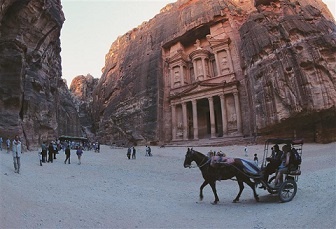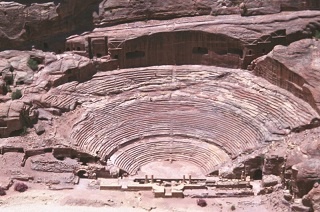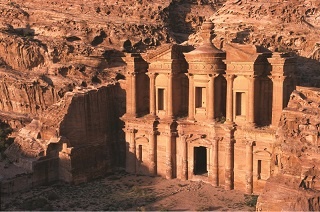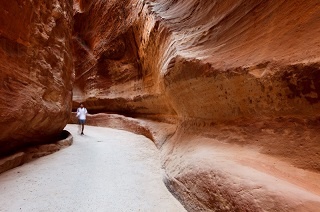LIM COLLEGE FACULTY BLOG
Petra Perfect By Night And Day
posted by Fred Steinberg, Adjunct Faculty in Marketing, Management & Finance
 Petra, the awesome Arabian desert city carved into sheer rock, has been selected by Travel & Leisure magazine as one of its 2017 “25 Trips of a Lifetime.” Petra was built in the third century BC by the nomadic Nabataean tribe who made it their capital and created palaces, temples, tombs, various rooms and stables from the sandstone cliffs. It was from Petra that the Nabataeans dominated the trade routes where caravans carried spices, silk and slaves from Damascus to Arabia with links to China, India, Greece and Rome. Masters of iron production, copper refining, stone carving and hydraulic engineering, which provided sufficient water using a series of dams, conduits and cisterns, they built a spectacular city financed by taxes and protection money collected from passing caravans.
Petra, the awesome Arabian desert city carved into sheer rock, has been selected by Travel & Leisure magazine as one of its 2017 “25 Trips of a Lifetime.” Petra was built in the third century BC by the nomadic Nabataean tribe who made it their capital and created palaces, temples, tombs, various rooms and stables from the sandstone cliffs. It was from Petra that the Nabataeans dominated the trade routes where caravans carried spices, silk and slaves from Damascus to Arabia with links to China, India, Greece and Rome. Masters of iron production, copper refining, stone carving and hydraulic engineering, which provided sufficient water using a series of dams, conduits and cisterns, they built a spectacular city financed by taxes and protection money collected from passing caravans.
 A UNESCO World Heritage Site, one of the new “7 World Wonders” and most visited attraction in Jordan, UNESCO described the site as “one of the most precious properties of man’s cultural heritage.” Often called “Jordan’s Lost City,” Petra was unknown to the West until 1812 when it was “rediscovered” by Swiss explorer Johann Burckhardt. Tourist visits spiked after the site was featured in scenes from the 1989 film Indiana Jones and the Lost Crusade.
A UNESCO World Heritage Site, one of the new “7 World Wonders” and most visited attraction in Jordan, UNESCO described the site as “one of the most precious properties of man’s cultural heritage.” Often called “Jordan’s Lost City,” Petra was unknown to the West until 1812 when it was “rediscovered” by Swiss explorer Johann Burckhardt. Tourist visits spiked after the site was featured in scenes from the 1989 film Indiana Jones and the Lost Crusade.
You approach the 100-sq. mile Petra valley through a 1.5-mile descending pathway which includes a ¾ mile sheer, narrow gorge or “Siq,” whose vertical walls are the result of natural mountains splitting by violent tectonic forces. The “Siq” opens into a huge plaza where you experience Petra’s most breathtaking site – the façade of the City’s Treasury, some 130-ft. high and decorated with Corinthian figures, friezes and other carvings. Actually most likely a temple and tomb, the Treasury gets its name from the mistaken belief that an Egyptian pharaoh hid his treasure in the highest urn. The facade of the rose-colored Treasury features Greek-style pillars, alcoves and stone carvings which are masterpieces of giant masonry work.
 From the Treasury, you walk the broad “Street of Tombs,” viewing the intricate wall carvings of some 50 giant tombs sculptured into the canyon’s cliffs, their façade topped with crow-steps, pilasters and cavettos. Adjacent is the High Place of Sacrifice, a hill-top altar site of worship used for important religious ceremonies, which requires a 45-minute climb. Under the High Place of Sacrifice is a large plaza and second most dramatic site – the over 5,000-seat Roman-style Amphitheater. Seven stairways ascend the huge auditorium, the only one in the world carved into a giant rock. Almost enclosing the Theater on three sides are rose-colored mountain wall carvings of towers cut from the rock.
From the Treasury, you walk the broad “Street of Tombs,” viewing the intricate wall carvings of some 50 giant tombs sculptured into the canyon’s cliffs, their façade topped with crow-steps, pilasters and cavettos. Adjacent is the High Place of Sacrifice, a hill-top altar site of worship used for important religious ceremonies, which requires a 45-minute climb. Under the High Place of Sacrifice is a large plaza and second most dramatic site – the over 5,000-seat Roman-style Amphitheater. Seven stairways ascend the huge auditorium, the only one in the world carved into a giant rock. Almost enclosing the Theater on three sides are rose-colored mountain wall carvings of towers cut from the rock.
Across from the theater you will see the Royal Tombs, the most impressive burial places in Petra. The Tombs four adjacent facades, which are cut into steep cliffs, represent some of the finest carvings in Petra. The Urn Tomb contains a deep courtyard with colonnades on two sides, the Silk Tomb façade features swirls of colored rock and the Palace Tomb is well worth the 30-minute climb to view close-up. Continuing along the Street of Tombs, you pass the front of the elevated Great Temple, the Temple of the Winged Lions and the stately Nabataean Temple, one of the few free-standing structures in Petra.
You soon reach the end of the valley and the start of the winding path to the third of Petra’s most dramatic sites, the “Ad Deir” Monastery. The winding path features an 850-ft. high staircase, a close to one-hour climbing challenge, best to take in the early morning or late afternoon, especially during the warmer summer months. However, horse or donkey rides to the top are available. Built in Byzantine times, around 86 BC, and Petra’s largest monument, the Monastery’s giant façade was a church entrance. The interior contains benches and an altar against the rear wall, used for religious ceremonies and meetings. Crosses were carved in the rear wall when the hall was used as a Christian chapel.
There are a number of ways to visit Petra. Day trips are available from both Amman, Jordan’s capital, and Eilat in Israel. While the trip from Amman can be completed in just over three hours, the ride from Eilat can often take four and more, depending on the delays at the Jordanian border. The result can be a very long day in which your travel time is longer than your Petra visit time. Both day trips miss the early morning and late afternoon times to visit the valley – the best hours from a crowd and weather point of view, especially in the summer.
And day trippers of course miss the fascinating Petra By Night experience where you descend into the site an hour after sundown, guided by the light of 1,000 candles lining the path into the valley. You enter the Treasury plaza which glows with the light and shadows from some 200 candles with the Treasury building providing a dramatic illuminated backdrop. After sitting, you are served sweet local tea, listen to a short history of the site and its excavation followed by a brief concert by ancient Arabian wind and string instruments and Arab chants. You then retrace your walk back up to the valley entrance – completing a very special two-hour experience.
 When visiting Petra, you might want to stay, as my wife and I did, at the lovely 5-star Movenpick Petra Resort—just 50 yards from the historic site’s entrance. The 180-room resort features a wide variety of accommodations and amenities including a large outdoor pool and small exercise room. Its international breakfast buffet is outstanding and the lobby bar features two giant Mediterranean hand-made mosaic wall hangings. And the hotel’s Al Ghadir rooftop bar and barbecue, is a lovely informal spot for a drink and sunset watching.
When visiting Petra, you might want to stay, as my wife and I did, at the lovely 5-star Movenpick Petra Resort—just 50 yards from the historic site’s entrance. The 180-room resort features a wide variety of accommodations and amenities including a large outdoor pool and small exercise room. Its international breakfast buffet is outstanding and the lobby bar features two giant Mediterranean hand-made mosaic wall hangings. And the hotel’s Al Ghadir rooftop bar and barbecue, is a lovely informal spot for a drink and sunset watching.
To enjoy the best of Petra then, stay overnight when you can visit in the late afternoon and early morning (the site is open at sunrise and closed an hour or so before sunset) and can experience Petra By Night. And if you overnight from Amman, by far the best way to experience Petra, there are two good choices for stops on the way or way back. One is Madaba “the city of mosaics,” whose chief attraction in the Greek Orthodox Church of St. George, is a 6th century, two million-piece mosaic map showing Jerusalem and other holy sites. Some 75x15 ft., the mosaic depicts regional hills, valleys, villages and towns from as far as the Nile Delta. A second possible stop between Petra and Amman would be the walled, crusader city of Karak, dominated by Karak Castle, the largest in Jordan and also featuring a-number-of carefully restored 19th century Ottoman buildings.
An overnight Petra visit, preferably in the better weather spring or fall, should well be among your personal 25 places to see in a lifetime.
Photos: Courtesy of Jordan Tourism Board